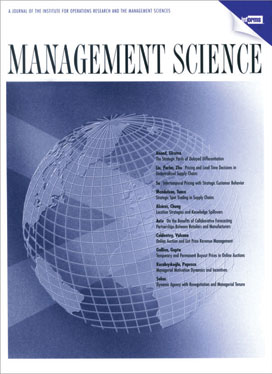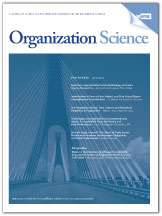Academic articles
Practitioner articles
Working papers
Books
Book chapters
Case studies
Other publications
Subject(s)
Product and operations management
Keyword(s)
Supply chain management, uncertain consumer taste, product introduction, product positioning, store brands, national brands, information acquisition, information sharing, vertical differentiation, horizontal differentiation
In this paper, we study how a retailer can benefit from acquiring consumer taste information in the presence of competition between the retailers store brand (SB) and a manufacturers national brand (NB). In our model, there is ex-ante uncertainty about consumer preferences for distinct product features, and the retailer has an advantage in resolving this uncertainty because of his close proximity to consumers. Our focus is on the impact of the retailers information acquisition and disclosure strategy on the positioning of the brands. Our analysis reveals that acquiring taste information allows the retailer to make better SB positioning decisions. Information disclosure, however, enables the manufacturer to make better NB positioning decisions – which in return may benefit or hurt the retailer. For instance, if a particular product feature is quite popular, then it is beneficial for the retailer to incorporate that feature into the SB, and inform the manufacturer so that the NB also includes this feature. Information sharing, in these circumstances, benefits both the retailer and the manufacturer, even though it increases the intensity of competition between the brands. But, there are situations in which the retailer refrains from information sharing so that a potentially poor positioning decision by the NB makes the SB the only provider of the popular feature. The retailer always benefits from acquiring information. However, it is beneficial to the manufacturer only if the retailer does not introduce an SB due to the associated high fixed cost.
With permission of Elsevier
Volume
268
Journal Pages
555–568
Subject(s)
Information technology and systems; Technology, R&D management
Keyword(s)
Cybersecurity, information security, legislation, risk management
With the increasing importance of the security of information technology for all areas of life, the IT security law has developed step by step without the European and German legislation being able to follow an overall draft. At the latest with the IT security regulations in the General Data Protection Regulation and the expansion of sector-specific regulations on IT security, questions of the systematization of the new area of law arise. The authors examine three key questions - the modeling of systems subject to the law, the concept of risk management, and the determination of the state of the art security measures. Finally, they outline the main elements of a restructuring of IT security law.
[Das IT-Sicherheitsrecht will die IT-Sicherheit schützen, folgt aber weder auf europäischer noch auf deutscher Gesetzgebungsebene einem Gesamtentwurf. Der Beitrag geht drei Schlüsselfragen nach – der Modellierung der dem Recht unterworfenen Systeme (II.), dem Risikobegriff (III.) sowie der Ermittlung des Standes der Technik (IV.) – und entwirft Grundzüge einer Strukturierung des IT-Sicherheitsrechts (V.).]
Volume
34
Journal Pages
706–720
ISSN (Online)
2194-4172
Subject(s)
Human resources management/organizational behavior
Keyword(s)
Negotiation, alternatives, power, first offer, mental simulation
The present research demonstrates that negotiators can act powerfully without having power. Researchers and practitioners advise people to obtain strong alternatives prior to negotiating to enhance their power. However, alternatives are not always readily available, often forcing negotiators to negotiate without much, or any, power. Building on research suggesting that subjective feelings of power and objective outcomes are disconnected and that mental simulation can increase individuals' aspirations, we hypothesized that the mental imagery of a strong alternative could provide similar psychological benefits to having an actual alternative. Our studies demonstrate that imagining strong alternatives causes individuals to negotiate more ambitiously and provides them with a distributive advantage: negotiators reached more profitable agreements when they either had a strong tendency to think about better alternatives (Study 1) or when they were instructed to mentally simulate an attractive alternative (Studies 3-4). Mediation analyses suggest that mental simulation boosts performance because it increases negotiators' aspirations which translate into more ambitious first offers (Studies 2-4), but only when the simulated alternative is attractive (Study 2b). Our findings further show that mental simulations are only beneficial when there is sufficient room in the negotiation to reach a profitable agreement, but backfire in settings where negotiators' positions are difficult to reconcile (Study 5). An internal meta-analysis of the file-drawer produces effect size estimates free of publication bias and demonstrates the robustness of the effect. Our findings contribute to research on social power, negotiations, and mental simulation.
Copyright © 2018 American Psychological Association.
Reproduced with permission.
Volume
115
Journal Pages
96–117
ISSN (Online)
1939-1315
ISSN (Print)
0022-3514
Subject(s)
Product and operations management
Keyword(s)
Pricing, choice behavior, rational inattention, information acquisition, signaling game
We study the optimal pricing problem of a monopolistic firm facing customers with limited attention and capability to process information about the value (quality) of a single offered product. We model customer choice based on the theory of rational inattention in the economics literature, which enables us to capture not only the impact of true quality and price, but also the intricate effects of customer’s prior beliefs and cost of information acquisition and processing. We formulate the firm’s price optimization problem assuming that the firm can also use the price to signal the quality of the product to customers. To delineate the economic incentives of the firm, we first characterize the pricing and revenue implications of customer’s limited attention without signaling, and then use these results to explore Perfect Bayesian Equilbiria (PBE) of the strategic pricing signaling game. As an extension, we consider heterogeneous customers with different information costs as well as prior beliefs. We discuss the managerial implications of our key findings and prescribe insights regarding information provision and product positioning.
© 2017, INFORMS
Volume
64
Journal Pages
2995–3014
ISSN (Online)
1526-5501
ISSN (Print)
0025–1909
Subject(s)
Human resources management/organizational behavior; Marketing
Keyword(s)
Sales, leadership, price negotiations, salesperson–customer interaction, transformational leadership, social learning
JEL Code(s)
M310
Volume
46
Journal Pages
703–724
Subject(s)
Human resources management/organizational behavior; Management sciences, decision sciences and quantitative methods
Keyword(s)
Competition, conflict, social networks, status, tournaments
JEL Code(s)
D74, J28
Volume
115
Journal Pages
E3361–E3367
Subject(s)
Technology, R&D management
Keyword(s)
Organizations, universities, knowledge, networks, interdisciplinarity, centers
Many universities have developed large-scale interdisciplinary research centers to address societal challenges and to attract the attention of private philanthropists and federal agencies. However, prior studies have mostly shown that interdisciplinary centers relate to a narrow band of outcomes such as publishing and grants. Therefore, we shift attention to include outcomes that have been the centers mandate to influence - namely outreach to the media and private industry, as well as broader research endeavors and securing external funding. Using data covering Stanford University between 1993 and 2014, we study if being weakly and strongly affiliated with interdisciplinary centers in one year relates to and increases (1) knowledge production (publications, grants, and inventions), (2) instruction (numbers of students taught, PhDs, and postdocs advised), (3) intellectual prominence (media mentions, awards won and centrality within the larger collaboration network), and (4) the acquisition of various sources of funding in the next year. Our results indicate that interdisciplinary centers select productive faculty and increase their activity on a broad range of outcomes further, and in ways greater than departments and traditional interdisciplinary memberships, such as courtesy and joint appointments.
With permission of Elsevier
Volume
47
Journal Pages
543–557
Subject(s)
Strategy and general management
Keyword(s)
Inter-organizational trust; Propensity to trust; Willingness to rely on trust; Trustworthiness; Contextual factors in trust; Demographic factors in trust; Contractual safeguards; International joint ventures (IJVs) and collaborations
JEL Code(s)
M16
We examine how 712 executives from several countries, industries and backgrounds are willing to rely on trust (WTRT) when entering a collaborative venture where both partners are at risk. Presented with a specific partnership opportunity they were asked about the level of safeguards required to enter into an agreement. We test for the impact of contextual and demographic conditions and confirmed differences in WTRT between nationalities, but find that several contextual variables mediate this impact. Different nationalities treat three dimensions of trust (integrity, reliability, and benevolence) differently as they are shown to be time dependent. We conclude that context is as important as demography in determining an executive’s WTRT.
With permission of Elsevier
Volume
53
Journal Pages
373–391
Subject(s)
Human resources management/organizational behavior; Strategy and general management
Keyword(s)
Organizational behavior, general management
This paper advances novel theory and evidence on the emergence of informal leadership networks in groups that feature no formally designated leaders or authority hierarchies. Integrating insights from relational schema and network theory, we develop and empirically test a 3-step process model. The model’s first hypothesis is that people use a “linear-ordering schema” to process information about leadership relations. Taking this hypothesis as a premise, the second hypothesis argues that whenever an individual experiences a particular leadership attribution to be inconsistent with the linear-ordering schema, s/he will tend to reduce the ensuing cognitive inconsistency by modifying that leadership attribution. Finally, the third hypothesis builds on this inconsistency-reduction mechanism to derive implications about a set of network-structural features (asymmetry, a-cyclicity, transitivity, popularity, and inverse-popularity) that are predicted to endogenously emerge as a group’s informal leadership network evolves. We find broad support for our proposed theoretical model using a multi-method, multi-study approach combining experimental and empirical data. Our study contributes to the organizational literature by illuminating a socio-cognitive dynamics underpinning the evolution of informal leadership structures in groups where formal authority plays a limited role.
© 2018, INFORMS
Volume
29
Journal Pages
118–133
Subject(s)
Management sciences, decision sciences and quantitative methods
Keyword(s)
Decomposition, Shapley value, Potential, Consistency, Higher-order contributions, Balanced contributions
JEL Code(s)
C71, D60
We suggest foundations for the Shapley value and for the naïve solution, which assigns to any player the difference between the worth of the grand coalition and its worth after this player left the game. To this end, we introduce the decomposition of solutions for cooperative games with transferable utility. A decomposer of a solution is another solution that splits the former into a direct part and an indirect part. While the direct part (the decomposer) measures a player's contribution in a game as such, the indirect part indicates how she affects the other players' direct contributions by leaving the game. The Shapley value turns out to be unique decomposable decomposer of the naïve solution.
With permission of Elsevier
Volume
108
Journal Pages
37–48


